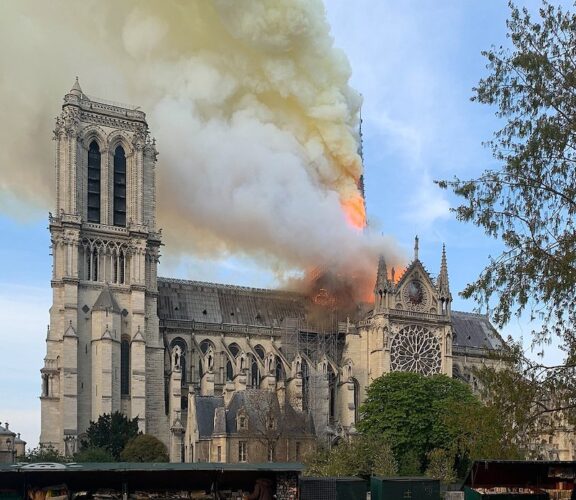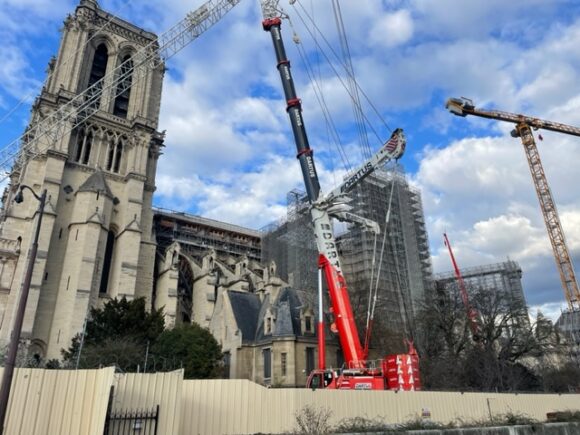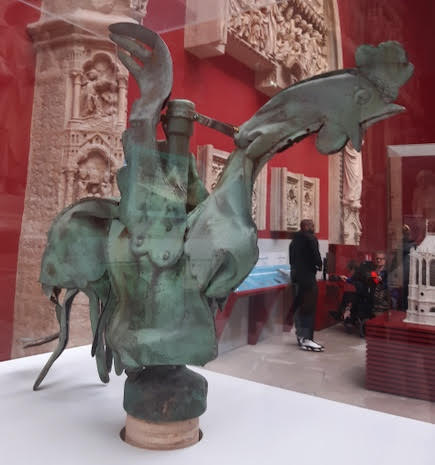
The spire and the rooster of Notre Dame will soon be back in the sky of Paris.

On April 15, 2019, the world watched in horror as the spire of Notre Dame was consumed by flames and finally crumbled down. It left a gaping hole in the cathedral at the center of its vault.
Four years later, the installation of a tabouret — (literally, a stool) — which, in this case, is a huge wood contraption intended to serve as the base of the new flèche (or spire), marked the beginning of a crucial stage in the restoration of the church.
The first flèche (spire) was erected in 1220-30 and removed at the end of the18th century. In 1859, architect Eugène-Emmanuel Viollet-le-Duc , carried by the revival of medieval art inspired by Romanticism and the publication in 1831 of “Notre Dame de Paris” by Victor Hugo , brought the dilapidated cathedral back to life and rendered it more medieval than before with new features like chimeras and gargoyles. His main creation was the flèche.
By the spring of 2018, the spire was in a state of disrepair. The 12-ft.-tall copper statues of 12 apostles and four evangelists, including a St. Thomas, which was the architect’s self portrait, were lifted by cranes creating something like a ballet in the sky. Scaffolding was put in place at the base of the spire to start the future restoration. It is believed that it was the exact place where the fire originated in April 2019 and spread to the wood frame or forêt under the roofs.
After heated debates between the world’s architects, engineers and art historians, it was decided to reconstruct the spire identical to its original appearance , including Viollet-le- Duc’s own vision of medieval art.
After all these years spent stabilizing the structure, putting robots to work to remove debris and toxic lead dust, recreating the stone sculptures, which had exploded under intense heat; reviving the brilliant colors of the stained glass windows; cleaning up the 15th century organ; and stripping walls, columns and 16th century paintings from the dark, slimy layer of dirt accumulated by tens of millions of visitors tramping through the building for centuries, five-star General Jean Louis Georgelin — appointed to oversee the restoration project by the French government — was able to announce, “Now, for the first time, we are starting to rebuild.”

TF1, one of the main French TV channels, aired a series of fascinating videos over several days during the week of April 14. Senior international reporter and historian Michel Izard took the viewers through the step by step restoration process of the new flèche, which will soar again into the sky by the end of 2023.
At 40 meters (131 ft.) from the ground, the installation of the tabouret at the intersection of the transept and nave is an impressive piece of work, weighing 80 tons and measuring 15 by 13 meters (49 x 43 ft.) The two beams of solid oak 10 meters long (33 ft.) are placed in the form of a cross. At the center a poinçon (a tool used to make holes ) will act as the spinal cord of the structure..
The installation of the spire was preceded by months of intense work in workshops outside Paris. For this operation, the best know-how and the best trees were required. France is lucky to have both. One thousand trees were selected in the oak forests of Lorraine. Those trees were out of the ordinary for the length of their trunks uninterrupted by branches.
After being felled, the 250-year-old trees had to be “squared” by hand, using an axe. It is a skill transmitted through generations. The few lumberjacks, who still know how to do this type of work are usually foreign. They live in the forest. The video showed a lumberjack from Croatia squaring the trunks in 1985. The Association of Carpenters Without Borders helps preserve the ancient wood-working methods.
The trees are worked while still green and soft, then dried for a period of one and half years. For the carpenters, working the wood while still alive, is a challenge. Working manually allows them to respect the grain of the wood and know each knot.
The logs of unusual length of 20 meters (or 60 ft.) had to be processed in special sawmills since very few mills are equipped to accommodate such operations.
A trial run of assembling the 110 pieces of the tabouret was carried out while they were lying flat on the ground, then that piece was dismantled to be lifted and put together again on top of the transept, at 30 meters (99 ft.) from ground level. This huge object was to be put in place with the precision of a Swiss watch-maker and fitted with specific measurements calculated in millimeters. As previously mentioned, the wood was still “alive” and allowances had to be made on occasion for a few millimeters resistance, since the wood — not being totally dry — could contract
Around 30 carpenters were selected from among the best in the world. They seemed enthusiastic and proud to work on Notre Dame. “We are going to go much higher,” one of them said with much excitement. Many of them are Compagnons du Devoir et du Tour de France, an élite school of craftsmen, who are taught methods used by generations of artisans going back to the Middle Ages.
The prestige of this school is comparable to the élite Grandes Ecoles. The school used to function in 49 countries but today, it is particularly active in France. The Compagnons learn a trade under a master as apprentices. They share their knowledge by traveling throughout France and live in hostels. In the Middle Ages, they helped build castles and churches. UNESCO wrote their charter.

Carpenters from four different companies from several countries are taking part in the spire’s reconstruction. The video showed carpenters from The Netherlands and England. Hank Silver and Miles Jenners, respectively from Vermont and Massachusetts, were beaming during an interview. They emanated pride for having being selected. They gave up their jobs to come to Paris. Today 1,000 people are working on the Notre Dame site, half of them inside the cathedral.
Women were also present on the flèche worksite. They variously draw épures (working draughts), are architects or site supervisors. Women were not accepted in the Compagnons du Devoir until 2005.
Like their 13th century medieval ancestors, the carpenters find the pencil and plumb-line their most dependable tools. But they also use oversized tools fabricated especially for this work. They need to use circular saws, mortaiseuses, to create notches, and laser beam to ensure the lines are straight.
Under the tabouret described above, a temporary floor was installed at 26 meters (85 ft.) from ground level.
It is at 31 meters (102 ft.) under the tabouret, that we find the complex vaulting system, which makes the gothic architecture so unique. The vault arches and rib vaulting rest on four pillars and on pieds de gerbe (sheaf foot) placed on top of each pillar that will support the whole weight of the spire structure.
The skilled grutier (crane driver) does a perilous job when he lifts and carries each stone of the ronde de pierre which supports the vault. The arches meet at the center at the clé de voûte or keystone. A medallion representing the Virgin Mary will again be painted with an azure background dotted with gold stars.
Similar to the wood cintres (half hangers), which had been custom-made to reinforce the flying buttresses in the early stage of the Notre Dame restoration, four large, custom-made pieces of wood or cintres each weighing one and a half tons were laid at the bottom of the hole left by the collapse of the spire in 2019 in order to reinforce the vaulting arches, which had also collapsed.
The 320-tons flèche, carved out of solid oak , will soar again into the sky at a height of 96 meters (315 ft.) The intricate framework will be pulled upward by giant beams.

The viewer of the video is invited to start his or her virtual ascent of the flèche. At 60 meters (197 ft.) one reaches an openwork balcony decorated with floral motives. From there, the view over Paris is breathtaking.
As one continues the virtual ascent, at 89 meters (292 ft.), one reaches a tiny platform big enough to stand with two feet … and free of vertigo.

Photo by Nicole Prévost Logan.
A copper rooster will again be perched on top of a rod and pivot in the wind. This will only be a replica. In 2021, a photo showed chief architect Philippe Villeneuve cradling the damaged rooster rescued from the debris. The original bird is now safe and permanently on display at the Cité de l’Architecture et du Patrimoine, Place du Tocadéro. In 1935, relics of the Holy Cross were placed inside the rooster, as well as relics of St Denis and Ste. Geneviève, patrons of Paris.
The wood framework of the new spire will be protected from rain by 140 tons of lead. On the video, the workers are shown doing what seems like a very dangerous process when, in a bucket, they mix the lead, which has been melted to a temperature of 320 degrees.
None of the construction of the spire will be shown to the public until completion. Like a rocket about to take off to the moon, the structure will be hidden behind scaffolding.
The flèche will be completed at the end of 2023. During that time, work will continue around the cathedral. Light will again pour into the apse choir as the tall windows are reinstalled. The tarp covering the whole structure, like a giant umbrella, will be removed. There will be a last chance to have a close look on the newly-refreshed colors of the rose windows before the scaffolding is dismantled.
The stone work will return to its original, blonde color. For the first time, one will be able to see a Notre Dame not seen since eight centuries ago.
The fire at Notre Dame provoked a new awareness of the danger of fires and drastic measures are being taken in 90 French churches to prevent from the danger of fire such as coupe-feu or firewalls, treating charpente or framework under the roofs with fire-resistant products and amplifying the alarm system.
On April 16, French president Emmanuel Macron climbed up to the tabouret with his wife Brigitte. Two days later, on TV, he reiterated the promise made just one day after the fire that the cathedral would be whole again in 2024 .
By comparison, Notre Dame is 96 meters high (315 ft.), much smaller than Cologne cathedral with its 157 meters (515 ft.) spire. The latter’s construction ceased in 1473 and was not finished until 1880. Therefore it remained incomplete during medieval times.
Before the fire, Notre Dame received between 30,000 and 45,000 visitors per day or about 13 million a year – numbers comparable to the Louvre’s. This museum is thinking of capping the numbers of visitors at 30,000 a day.
Food for thought — perhaps it might be a good idea to apply the same rule to the cathedral both to preserve its pristine beauty and also remind the visitors that it is first and foremost a place of prayer and worship.
tor’s Note: This is the opinion of Nicole Prévost Logan.

About the author: Nicole Prévost Logan divides her time between Essex and Paris, spending summers in the former and winters in the latter. She writes an occasional column for us from her Paris home where her topics will include politics, economy, social unrest — mostly in France — but also in other European countries. She also covers a variety of art exhibits and the performing arts in Europe. Logan is the author of ‘Forever on the Road: A Franco-American Family’s Thirty Years in the Foreign Service,’ an autobiography of her life as the wife of an overseas diplomat, who lived in 10 foreign countries on three continents. Her experiences during her foreign service life included being in Lebanon when civil war erupted, excavating a medieval city in Moscow and spending a week under house arrest in Guinea.